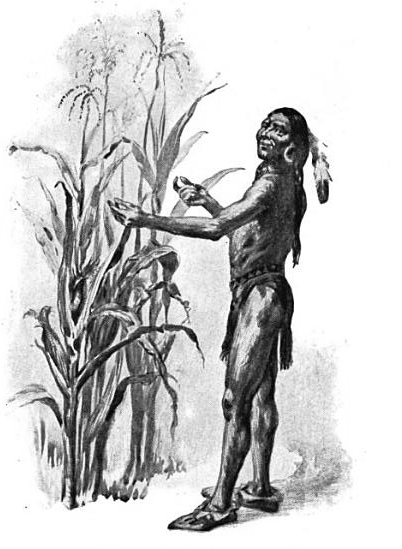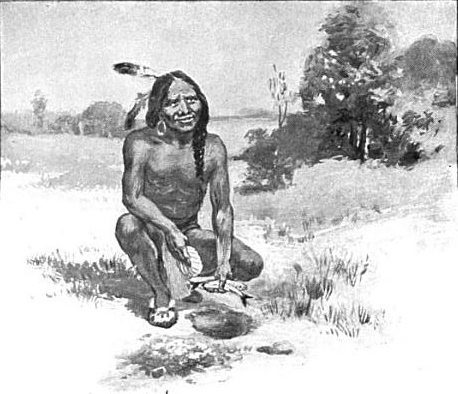Your search results [18 articles]
English on the Massachusetts coast in 1620.
New attempt at colonisation in 1620. The Mayflower left London in July 1620, and after two stopovers in Southampton and Dartmouth, set sail from Plymouth on 16 September. After a stopover in Newfoundland to get supplies from local fishermen, bad weather forced the ship to drop anchor at Cape Cod (Massachusetts) on 11 November, instead of reaching the mouth of the Hudson River, the initial goal of the voyage.
The ship's log states that Captain Christopher Jones and the colonists landed at Cape Cod because the storm was raging and the supplies of malt for brewing beer on board were almost exhausted. The captain had to reserve this malt for the sailors and their return journey, which could not take place until the spring of 1621. The other beverages on board the Mayflower were drunk, except the brandy. The families of colonists who landed on shore had to manage to find fresh water. William Bradford writes that in January and February 1621, the colonists on land died of scurvy, deprived of the beer that the sailors kept on board the Mayflower for their own use, until they themselves were decimated by scurvy :
“As this calamitie [scurvy] fell among the passengers that were to be left here to plant, and were hasted a shore and made to drinke water, that the sea-men might have the more beer and one in his sicknes desiring but a small cann of beere, it was answered, that if he were their owne father he should have none ; the disease began to fall amongst them also, so as allmost halfe of their company dyed before they went away, and many of their officers and lustiest men, as the boatson, gunner, 3. quarter-maisters, the cooke, and others. At which the mr was something strucken and sent to the sick a shore and tould the Govr he should send for beer for them that had need of it, though he drunke water homward bound.” [1]
Drinking water at that time meant running the greatest risks of disease in Europe. Rather beer than water. The settlers should build a brewery to get beer as soon as possible. But what to brew beer with when you are on the coasts of Massachusetts or Virginia in 1620?

The story of Squanto, a Patuxet Indian of the Wampanoag Confederacy, illustrates the dark underbelly of New England colonization: captured among others by slavers English captains, sold into slavery in Malaga on the African coast, bondage life in London, and return to his homeland where his entire tribe has been decimated by European diseases.
 “Thomas Hunt, captain of one of the ships in John Smith’s expedition to New England in 1614, captured twenty of the Patuxet Indians and seven Nausets and carried them to Malaga, where he sold them. The friars caused them to be released and Squanto found his way to England, where he was a servant of Mr. John Slanie, a merchant of London. Before the return of Squanto to New England the Patuxet tribe had been swept away by disease.” (Bradford’s history …, 111, n. 3).
“Thomas Hunt, captain of one of the ships in John Smith’s expedition to New England in 1614, captured twenty of the Patuxet Indians and seven Nausets and carried them to Malaga, where he sold them. The friars caused them to be released and Squanto found his way to England, where he was a servant of Mr. John Slanie, a merchant of London. Before the return of Squanto to New England the Patuxet tribe had been swept away by disease.” (Bradford’s history …, 111, n. 3).
With maize. How to grow it? Without the help, knowledge and expertise in growing maize of a Native American named Squanto (or Tisquantum), the colony would have starved to death. Arriving in the middle of winter with meagre provisions and already mouldy wheat seeds, the settlers had to quickly plant and cultivate in the spring of 1621 :
"He [Squanto] directed them how to set their corne, where to take fish, and to procure other commodities, and was also their pilot to bring them to unknown places for their profit, and never left them till he died [in November, 1622].” (Bradford 1620, 111)
The settlers have to negotiate with the Amerindian chiefs to obtain maize seeds, in addition to the maize they discovered and took from a cache on their arrival.
“And last of all, our Governor requested one favour of him, which was that he would exchange some of their Corn for seed with us, that we might make trial which best agreed with the soil where we live.” (Mourt’s Relation, 100)
They can then, with Squanto's advice, sow maize on their own account :
“We set the last Spring some twenty acres of Indian Corne, and sowed some six Acres of Barly and Pease … Our Corn did proue well, & God be praised, we had a good increase of Indian-Corne, and our Barly indifferent good, but our Pease not worth the gathering …"(Mourt’s Relation, 132-133, A letter to George Morton in 1622).
Samoset, a Sagamore Indian from Monhegan in Maine, who came to meet the colonists on 16 March 1621, speaks some English learned from those who were trading on their own account on the American coast. He was well received and showed that he was familiar with alcoholic drinks:
“he asked some beer, but we gave him strong water, and bisket, and butter, and cheese, & pudding, and a peece of a mallerd, all which he liked well, and had bin acquainted with such amongst the English;” (Mourt's relation or journal of the plantation at Plymouth, 1622, 84).
The colonists that immigrated from Europe placed a great deal of importance on their alcoholic beverages. "The Puritans set sail for the New World with 14 tons of water, 42 tons of beer, and 10,000 gallons of wine" (Anderson, 1988, preface). Samoset assisted the Pilgrims in the first winter and became an enthusiastic participant in the use of alcohol in their first Thanksgiving feast (Abbot Lender & Martin, 1982). Quoted by Abbot 1996 p. 7).
On the Virginia coast in 1620.
In 1606, the English sent ships to Virginia, which had recently been purchased from Spain. The colony was decimated by famine, malaria and harsh winters. The fort at Jamestown was destroyed by the Amerindians. The colonisation of Virginia also began in 1607 on an island in the Chesapeake Bay, a territory of the Powhatans. It was led by the Virginia Company of London, founded by the King of England, which traded in tobacco and sassafras
George Thorpe, around 1620, described the difficulties of growing and malting barley in Virginia, largely brought on by the summer's heat. Thorpe conceded two facts. First: settlers can drink the best fresh water but their do not dare (disease of their mind). Second: he can drink a good beer brewed with Indian corn
" … I thanke God I never had my health better in my life then I haue had since my cominge into this Countrey and I coulde saie the like of diuers others and am [per]swaded that more doe die here of the disease of their minde then of theire body by hauinge this countrey victuall[s] ouer-praised vnto them in England & by not knowinge they shall drinke water here although god-bethanked this countrey meand[s] in plentie of victuall euerie daie (as I shall make appeare in or[par]ticular by wrytinge) and wee haue found a waie to make soe good drinke of Indian corne as I [pro]test I haue diuers times refused to drinke good stronge Englishe beare and chosen to drinke that."[2]
George Thorpe, from Gloucestershire (England), is a distiller, among other skills. He knew how to brew beer and distil it into whisky. When he arrived on the Virginia coast in 1620, he quickly found the solution: replace barley malt with maize malt. In the fall of 1620, George Thorpe was said to have distilled a batch of corn beer[3].
The English settlers quickly learned to brew beer with sprouted maize grains, as they were used to doing with barley or wheat malt in Europe.
The Nantucket Indians of the Massachusetts.
The Nantucket Island served as a refuge for the Wampanoag Indians, who were driven off Cape Cod by English colonisation in 1620 and referred to it as Nehantucket. In 1641, the colonists gradually invaded the island to fish or hunt whales. The cohabitation was more or less peaceful. In 1792, Zacchaeus Macy testified that the Amerindians of Nantucket had adopted the beer brewed by the Europeans: "The natives of Nantucket... at their feasts ... had several sorts of good food, and very good strong beer"[4]. Two centuries after the landing of the first settlers, this Native American beer from Nehantucket probably has a European origin.
The diet of the Nantucket Indians before the 16th century, studied by E. Little, was based primarily on marine animal and plant resources. The share of maize and other starchy plants was insignificant. This implies that the possibility of brewing beer was also negligible[5].
[1] Bradford’s History of Plymouth Plantation 1606-1646, 108-109. Nevertheless, the first scouts ashore find fresh water as good as beer or wine: “But at length they found water and refreshed themselves, being the first New-England water, they drunk of, and was now in their great thirst as pleasant unto them as wine or beer had been in foretimes”. (op. cit. 99). This did not prevent half the colonists from dying of scurvy in January-February 1621, having no fruit, vegetables nor beer. https://books.google.fr/books?id=PgGVzCQgjEIC&pg=PA104&dq=pilgrims+beer&hl=en&sa=X&ei=afCbUMqrH4jCswaT54C4DA&redir_esc=y#v=onepage&q=beer&f=false
[2] Letter from George Thorpe to John Smyth (December 19, 1620). This letter is about brewing and maize beer, not distillation. https://encyclopediavirginia.org/entries/letter-from-george-thorpe-to-john-smyth-december-19-1620/
[3] The inventory of George Thorpe's possessions drawn up at his death in 1634 includes a copper still and various brass vessels and plates : “ … Item a copper still, old 003 Item 4000 of 5d nayles 006 Item 2 sugger loufs 005 Item a brasse bakeinge pan with a hole in the side 002 Item great brasse pott 015 Item a litle iron pott 002 Item a mohaire gowne 020 Item all the plate, rings, & scales, the plate wayinge 43 oz 1/8 valued & prised 150 ”. https://encyclopediavirginia.org/entries/inventory-of-george-thorpes-estate-1634/
[4] Macy, Z. 1810 [1794] A Short Journal of the First Settling of the Island of Nantucket (1792). Collections of the Massachusetts Historical Society 3:155-160.
[5] Elizabeth A. Little and Margaret J. Schoeninger, The Late Woodland Diet on Nantucket Island and the Problem of Maize in Coastal New England, American Antiquity Vol. 60, No. 2 (Apr., 1995), pp. 351-368.



